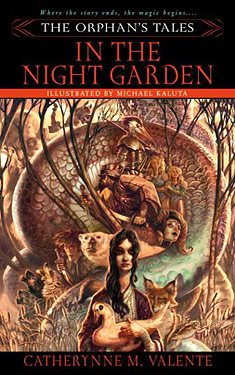WoGF Review: In the Night Garden by Catherynne M. Valente
 Alix Heintzman (alixheintzman) recently earned herself a graduate degree in history from the University of Vermont, and has circled back to her Old Kentucky Home with her partner Nick Stiner. She spends her time semi-desperately repairing the abandoned house they just bought, writing history high school curriculum, and reading fantasy books. She’s dipping her toes into the blogosphere at The Other Side of the Rain to sharpen her writing skills and also not-incidentally talk about the books she loves. And to spare Nick from endless discussions of plot details in books he hasn’t read.
Alix Heintzman (alixheintzman) recently earned herself a graduate degree in history from the University of Vermont, and has circled back to her Old Kentucky Home with her partner Nick Stiner. She spends her time semi-desperately repairing the abandoned house they just bought, writing history high school curriculum, and reading fantasy books. She’s dipping her toes into the blogosphere at The Other Side of the Rain to sharpen her writing skills and also not-incidentally talk about the books she loves. And to spare Nick from endless discussions of plot details in books he hasn’t read.
 In the Night Garden is essentially Arabian Nights, if Scheherazade had been a feminist literary critic with a working knowledge of world mythology and a wicked sense of irony. Certainly, this Scheherazade wouldn’t have ended up marrying the Sultan who put his first 1,000 wives to death.
In the Night Garden is essentially Arabian Nights, if Scheherazade had been a feminist literary critic with a working knowledge of world mythology and a wicked sense of irony. Certainly, this Scheherazade wouldn’t have ended up marrying the Sultan who put his first 1,000 wives to death.
It starts with a young girl with dark tattoos around her eyes: tiny, black letters spelling out hundreds of fairy tales. A young prince becomes obsessed with the girl’s stories, and very soon the reader and the young prince are both sitting in rapt silence in the night garden, listening. For maybe five pages, you feel you’re in comfortable, predictable territory. The tattooed girls tells of a prince who runs away from home and discovers a witch’s hut in the woods. Ah, you think, if he doesn’t watch his mouth he’ll be set three impossible tasks. Or he’ll be transformed into a pig, or a beast, or wind up living in an enchanted castle waiting for his true love to see past his ugliness and marry him. But the rules are different in the night garden. Instead, the witch woman emerges, horribly scarred, and tells the prince her story. The nesting stories continue, each one more unearthly and brilliant and unpredictable than the last.
Like Byatt’s The Djinn in the Nightingale’s Eye, In the Night Garden is both a loving homage to fairy tales, and a gleeful overturning of the tired tropes and values they represent. Fairy tales, as we all know, always have a moral lurking in their glittery depths. Sleeping Beauty and Snow White taught us that the secret to feminine allure is hibernation, Beauty and the Beast showed us that looks don’t matter unless you’re the girl, and Hansel and Gretel taught us that we shouldn’t eat other people’s houses. So what are the morals of Valente‘s fairy tales?
 First, she’s teaching us to embrace a larger, more colorful world than the tired European Middle Earth we all know and love. As a white woman raised on a healthy diet of Grimm and Lang, I expect my fairy tales to have castles, villages, inns, stepmothers, witches, and a nice temperate climate. But in The Night Garden there are djinns and gods, vast deserts, leviathans, fox-faced women and centaur kings. The cultural references are quiet, but wildly varied: the city of Al-a-Nur is vaguely African and Islamic; a mention of foot-binding puts us in pre-modern China; the mare-goddess belongs on the Mongolian steppe. It’s disorienting and wonderful.
First, she’s teaching us to embrace a larger, more colorful world than the tired European Middle Earth we all know and love. As a white woman raised on a healthy diet of Grimm and Lang, I expect my fairy tales to have castles, villages, inns, stepmothers, witches, and a nice temperate climate. But in The Night Garden there are djinns and gods, vast deserts, leviathans, fox-faced women and centaur kings. The cultural references are quiet, but wildly varied: the city of Al-a-Nur is vaguely African and Islamic; a mention of foot-binding puts us in pre-modern China; the mare-goddess belongs on the Mongolian steppe. It’s disorienting and wonderful.
She’s also teaching us to gently bury our girlhood visions of princesses and stepmothers. “Maidens stand still, they are lovely statues and all admire them,” says a pirate and former maiden, but “Witches do not stand still. I was neither, but better that I err on the side of witchery, witchery that unlocks towers and empties ships.” In the Night Garden passes the Bechdel test, as Nadine says, a hundred times over. It even passes the newly-minted Russo test, which I didn’t even know existed. Even more rarely, Valente doesn’t feel compelled to beat us into submission by shouting, Look, reader, it’s a Strong Female Character Rejecting Patriarchy. It’s much more subtle, powerful, and painfully simple: her women are old, ugly, beautiful, married, celibate, violent, magical, and everything else it is possible to be in a fairytale.
Finally, and maybe most importantly, Valente’s stories tell us that we should listen to the stories of the disempowered—what my dear post-colonial scholars would call subaltern voices. Her characters are the poor, dispossessed, monstrous, forgotten, and failed. There’s the orphan girl in some far northern fishing town, scrabbling for food and sleeping in the hulls of half-built boats. There’s a three-breasted Saint, an enslaved witch, a forgotten prophetess, a deer-footed princess, and a condemned Papess. The usual heroes—princes, kings, and wizards—are dangerous, ignorant characters who stomp heavy-footed through the stories. As one king tells his son, “Kings know there is only the Reign, and all things may be committed in its holy name…I have more blood on my hands than you could spill in a lifetime. I wear it proudly. It is my crown and my scepter.”
All these ambitions have their price: It takes an effort of concentration to follow all the winding stories and new characters and suddenly changing perspectives. The book can feel episodic, and there are unfinished threads and little fissures in the logic. It also takes a certain spirit of adventure; Valente takes you into the untracked fairytale wilderness and leaves you with nothing but a book of matches and a broken compass, without a familiar landmark in sight. It’s probably good for you. Because, in the end, In the Night Garden has the kinds of stories I’d like my (strictly imaginary) daughter to read. I’m eager to unearth the sequel, In the Cities of Coin and Spice.



















 Full Details
Full Details


2 Comments
Great review – thank you for posting. I discovered Valente through WOGF and I love her writing style. I’d really like to check this out when I get the opportunity.
Excellent review. I have some of her Fairyland books, but this one sounds even more intriguing.
Sorry, the comment form is closed at this time.